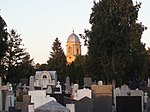Zemun (Serbian Cyrillic: Земун, pronounced [zěmuːn]; Hungarian: Zimony) is a municipality in the city of Belgrade. Zemun was a separate town that was absorbed into Belgrade in 1934. It lies on the right bank of the Danube river, upstream from downtown Belgrade. The development of New Belgrade in the late 20th century expanded the continuous urban area of Belgrade and merged it with Zemun.
The town was conquered by the Kingdom of Hungary in the 12th century and in the 15th century it was given as a personal possession to the Serbian despot Đurađ Branković. After the Serbian Despotate fell to the Ottoman Empire in 1459, Zemun became an important military outpost. Its strategic location near the confluence of the Sava and the Danube placed it in the center of the continued border wars between the Habsburg and the Ottoman empires. The Treaty of Belgrade of 1739 finally placed the town into Habsburg possession, the Military Frontier was organized in the region in 1746, and the town of Zemun was granted the rights of a military commune in 1749. In 1777, Zemun had 6,800 residents, half of which were ethnic Serbs, while another half of population was composed of Germans, Hungarians and Jews. With the abolishment of the Military Frontier in 1881, Zemun and the rest of the eastern Srem was included into Syrmia County of Kingdom of Croatia-Slavonia, part of Austria-Hungary. Following Austro-Hungarian defeat in World War I, Zemun returned to Serbian control on November 5, 1918 and became part of the Kingdom of Serbs, Croats and Slovenes (later Kingdom of Yugoslavia).
According to the 2011 census results, the municipality of Zemun has a population of 168,170 inhabitants. Apart from the Zemun proper, the municipality includes suburbs of Batajnica, Ugrinovci, Zemun Polje and Nova Galenika to the northwest.










